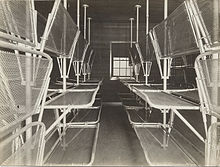User:Sacharyn/sandbox
History
[edit]
Known as “Ellis Island of the West”, the Angel Island Immigration Station in the San Francisco Bay was conceived of in 1903, completed in 1908, and opened in 1910. The federal immigration facility comprised of a hospital, an administration building, detention barracks, twelve employee cottages, a power house, and a wooden wharf that extended 200 feet out into the bay. The isolated location helped to securely monitor the thousands of people arriving in the United States from countries such as China, Japan, Korea, the Philippines, South America, and Russia. Immigrants were detained for long periods and forced to undergo invasive medical inspection, detailed immigration hearings, and prolonged waits for appeals against deportation. The majority of those detained over extended periods were Chinese which reflected the station’s additional purposes of enforcing the Chinese Exclusion Act and other anti-Asian immigration policies.
Interrogation process
[edit]Conditions
[edit]
Due to rural China’s poor health conditions, some Chinese immigrants were afflicted with disease and were forced to spend days in the infirmary. These diseases were exacerbated by the lack of isolation facilities in the hospitals and the unsanitary conditions in the living quarters which also affected the health of other immigrants. They were without soap and toilet paper for more than twenty years and only at the insistence of the Angel Island Liberty Association, a detainees’ organization, did authorities begin to provide them. Janitorial services were limited which left the kitchen and dining areas unclean and the toilet and bathing facilities were inadequate. Rooms were overcrowded and had poor ventilation. Drinking water was inaccessible and detainees were allowed to exercise only two to three hours a day. The station was insufficiently fireproof and burned down in 1940. The immigrants were moved to Sansome Street in San Francisco.
Poetry
[edit]Outcome
[edit]
During World War II, the immigration station served as an interment center for German and Japanese prisoners of war and federal prisoners. The island was declared surplus by the military in 1946 and was neglected during the postwar years. It was scheduled for demolition until the scores of poems were discovered on the walls of the barracks in 1970 by a state park ranger. This find inspired members of the local community to form the Angel Island Immigration Station Historical Advisory Committee which secured $250,000 to save the barracks building from deterioration. Local advocates and volunteers from an affiliate group, the Angel Island Association, became the unofficial custodians of the site and restored the barracks in 1981. The association coordinated public tours through the rooms of the barracks and in 1997, the Immigration Station was determined eligible for National Landmark status. On January 21, 2010, President Obama officially proclaimed National Angel Island Day.
References
[edit]- Cresswell, Tim, & Hoskins, Gareth. Place, Persistence, and Practice: Evaluating Historical Significance at Angel Island, San Francisco, and Maxwell Street, Chicago. Annals of the Association of American Geographers, 2008, pp. 392-413.
- Ciadiello, AV. Is Angel Island the Ellis Island of the West? Teaching Multiple Perspective-Taking in American Immigration History. Social Studies. 103, 4, 171, July 2012. ISSN: 00377996.

